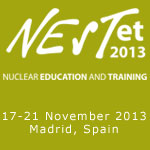
Austrian and German Young Generation Excursion France 14.04 – 17.04 2013
Visiting the south of France with the YGN was a project that had been a long time in the making. The idea to visit the Superphénix facility at Creys-Malville first took shape in 2011. As the organisational effort required was demanding it took almost two years to finalise the visit.
The SFEN-YGN provided the link (thanks to Benjamin Levi) to the French facilities and Lars Holt, from the German YGN, and your truly organised the necessary travel arrangements.
The visit began on Sunday 14 April with a joint dinner with a few people from the SFEN in a lovely restaurant in the old city district of Lyon.
On Monday morning, 15 April, all 18 participants gathered together to take the TGV (high speed train) and a bus to the Le Creusot forge. After an interesting presentation about the facility and the part that it plays in the nuclear fuel cycle we got changed and walked right into the foundry hall. Luckily, there was an ingot just coming out of the furnace, ready to be forged. Our guide (Mr. Picot) told us about the different processes involved, the products that Le Creusot manufactures (from loop lines to pressurizers and steam generator and pressure vessel parts) and the different production methods (with whole, short and longer sized ingots). He also mentioned that the cranes transporting the ingots to the furnaces were for a very long time operated exclusively by women.
He also showed us the workshop where the forged parts are cleaned and polished or tested for their material properties. The scrap facility for materials is situated close to the facility, and special trains carry the already warm ingots to the forge.
After a short lunch at Le Creusot, we drove to Chalon-St. Marcel to visit facilities involved in the next part of the cycle. In the Chalon factory the steam generators and pressure vessels are assembled. We were shown new hole drilling machines and were accompanied to where the light medium-sized and heavy components are assembled and where the full steam generators and pressure vessels await shipment to the facilities. The name of each section of the workshop relates to the max lifting force of the cranes used there. The last crane, which places the components onto the ships, has a power of 1000t. Mrs. Vaudon, the Executive Director of SFEN, was our guide on this occasion. She led us safely through all the different parts of the facility and very kindly helped us with some administrative problems.
The next day, Tuesday 16 April, there was also an early start. The bus for the Superphénix left at 7.30 a.m. Although the bus driver needed to be convinced to take us there, we arrived at the facility on time. The security measures there were strict and it took us quite a while to get clearance for entry.
We first had a chance to take a look at the visitor exhibition, which explained different forms of energy production, and then got a good overview of the facility and its history. A retired woman who still works occasionally then joined us and gave us a brilliant guided tour of the facilities in English.
To enter the facility we had to take the bus, which drove around the premises. Inside the facility we had not only to cover our hair and heads with nets and helmets, but also to check our clothing to make sure that we weren’t wearing any other fabric other than cotton. The reason for this is simple: in the facility there is a higher radon concentration level than elsewhere and radon likes all fabrics except for cotton. The group was accompanied by three different people - each of them capable of answering our sometimes very specific questions. We got a good and clear overview of all the necessary components that make up this fast reactor. We were even allowed to visit the former hot cells, where all the fuel elements were checked before being sent to the storage area.
After lunch in the factory cafeteria we went back to Lyon. Our original plan was to do a boat tour in the afternoon, but this was impossible because of high water level of the river Saone.
On Wednesday, 17 April, at 6.30 a.m. we left Lyon for Avignon, or more correctly for Marcoule – the MELOX facility. We were welcomed there by Mr. Combaluzier, who accompanied us to the lecture hall. The presentation he gave about the facility was in German, which was a very kind gesture. To enter the facility and the production areas we had first to fully change into “visitor suits.” Everyone got an individual changing room with a name sticker.

We were separated into two groups and visited several stages along the MOX fuel production line. The production is mainly done in glove boxes due to the high risk of plutonium contamination. We saw the preparation of the sinter process, the control rooms for the sinter processes, the quality checks after the sinter process, the final element assembly process and the rod scanning and quality assurance station.
After each room that we visited we had to do a contamination check, which gave our guide enough time to answer all our questions. Also, I would like to mention the excellent choice of guides for our group. Not only was their English perfect, but their knowledge of the site was very impressive too.
We then had a small lunch buffet and a chance to network with our hosts before returning to Avignon and taking the train to Lyon.
I would like to thank all organizers for their excellent collaboration, the various facilities that we visited for the way they made access so easy for us and, finally, all the participants for the interest that they showed throughout the excursion.
Eileen Radde, Austrian YGN, Seibersdorf, Austria, 25 April 2013
|



